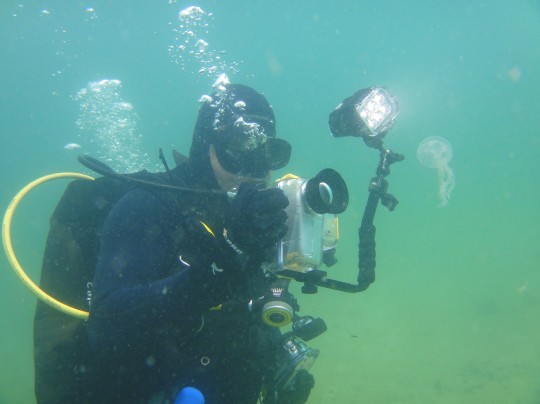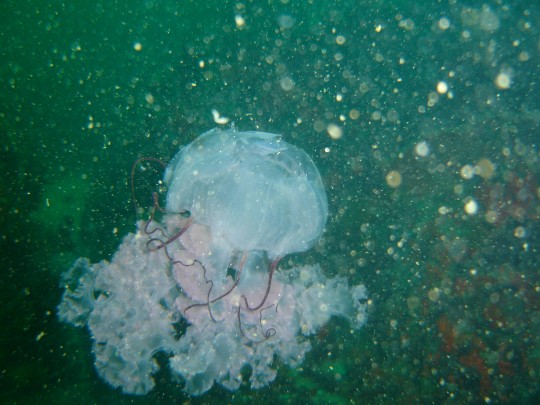There’s a surprising variety of sea jellies to be seen in Cape Town, and one of the pleasures of a deep dive is hanging at the safety stop watching the passing jellyfish traffic. You’re almost guaranteed to see something cool… from a sea gooseberry, with its little disco lights pulsating along the ribbing on its sides, to a huge sea jelly (Tony has seen one half a metre across at Long Beach). They’re fun to photograph – though it’s always a bit of a lucky dip because you often can’t see the jelly in your viewfinder.

Their outer mantles are super fragile, so it’s not cool to poke at them (even though it is tempting) – you can damage their bodies with a careless finger. I’ve seen divers harrassing jellyfish at the safety stop, and while it may seem like fun, it’s mean and destructive.

We see a lot of box sea jellies at Long Beach. They have four long tentacles, one on each corner of their boxy bodies. Tony was delighted to discover recently that they can retract their tentacles at will. We often see individuals with what looks like missing or damaged tentacles, but these little guys can adjust the length of their tentacles if they bump into something. They do also shed tentacles if they are stressed or get caught in something.

I like the night light sea jellies – they’re quite extravagant looking and their pink colour is very pretty. This one was photographed in somewhat dodgy visibility at Boat Rock in False Bay.

At a safety stop above the SAS Good Hope two weekends ago we saw a compass sea jelly for the first time. The water was very green and I’d had such a stressful dive I really wasn’t in a condition to take beautiful pictures, so this is the best I managed (he is upside down, tentacles pointing upwards):

Most of the varieties found here do have a nasty sting, but none of them will kill you. Fortunately we usually dive wearing so much neoprene that the only parts exposed are thin slivers of skin around the mouth and mask… But it is worth taking care anyway. First aid for jellyfish stings involves rinsing the area in vinegar or (if none is available) salt water. This stops the stinging cells from firing. Scrape off remaining tentacles gently with a blunt object. Alcohol or ammonia also works for the rinsing.

On the subject of sea jellies, check out SA Jelly Watch at the University of the Western Cape if you’re a fan of these wobbly wonders. There’s information on different types, and an appeal for good photos of sea jellies to add to their census of what kinds can be found where.








Comments are closed.